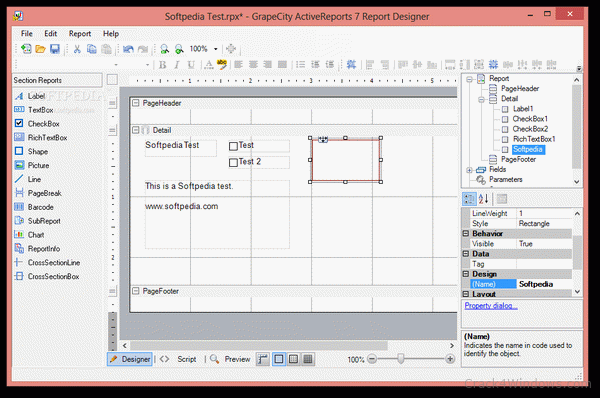
- #Activereports 7 detail install#
- #Activereports 7 detail code#
- #Activereports 7 detail download#
- #Activereports 7 detail windows#
GhHeader2.ColumnLayout = true // this header is specific to each columns of the detail section GhHeader1.ColumnLayout = false // this header span accross both detail columns This subreport is designed as follow: ghHeader1 (30) Set ARReportForm.aspx as the Start Page, run the cloud service and you will see that web-viewer shows the contacts that you added on step (24).My main report includes a subreport in the detail section. Rpt.DataSource = (from c in ds.Select() select new ).ToArray() ĪctiveReports allows you to use the collection of the objects as the data source, so we can use the result that is returned by ContactDataSource.Select method.
#Activereports 7 detail code#
(29) Add the following code to the Page_Load event handler of ARReportForm: (28) Add ActiveReports6 web-based report viewer in ARReportForm page. (27) Add the new Web Form in the Web Role Project. Set DataField property to "Address"(without quotes) for the 2nd textbox. Set DataField property to "Name"(without quotes) for the 1st textbox. (26) Add two textboxes to the detail section of the report. (25) Add the new ActiveReports 6(code-based) File in the Web Role Project(in the root folder). We will show the contacts list using ActiveReports. (24) Add several contacts using the form on the default page of the cloud service.
#Activereports 7 detail windows#
However step 22(Create Test Storage Tables) is not needed with Windows Azure SDK 1.1. Steps (7)-(23) are the same as in Table Storage Walkthrough.

(6) Add the reference to in Web Role project. I've added them as a link in my test project).

(alternatively you can include the *.cs files from StorageClient solution to the Web Role project. From the Web Role add the reference to StorageClient assembly. (5) Compile StorageClient solution that is included in the advanced samples obtained on step (2). (4) In the pop-up dialog add C# ASP.NET Web Role into the Cloud Service Solution. (3) In Visual Studio 2008 or 2010 create the new Windows Azure Cloud Service project.
#Activereports 7 detail download#
(2) Download and extract Windows Azure Additional Samples from MSDN code gallery.
#Activereports 7 detail install#
Install the latest release of ActiveReports6. (1) Get started with Windows Azure - install the prerequisites and SDK v1.1. I just aligned it with the changes in Windows Azure SDK v1.1 and added the steps for show the data using ActiveReports. This walkthrough is totally based on "Windows Azure Walkthrough: Table Storage". A few things was changed in version 1.1, I highlighted them later in this post. However, that blog post sample uses Windows Azure SDK 1.0 and I used the newer version 1.1. This walkthrough is based on the post in "Cloudy in Seattle" blog. I believe that the best way to show how ActiveReports can be used with the table storage is going through the live example. The details of table storage is not the subject of this post. Table storage is object-oriented and saves the entities and the entity properties.

Windows Azure Table Storage differs from the tables in a relational database. I believe that it will be useful for someone. But ActiveReports team did the great job for preparing Service Pack 1 which includes the fix for those issues! And this blog post repeats the "show the table storage data" walkthrough for ActiveReports6 SP1. Originally I planned to compose that blog post around both of Data Dynamics Reports and ActiveReports but then I found that the latter has the issues with running against a cloud environment. Some time ago I blogged about using Data Dynamics Reports to visualize the data that are stored in Windows Azure Table Storage.


 0 kommentar(er)
0 kommentar(er)
